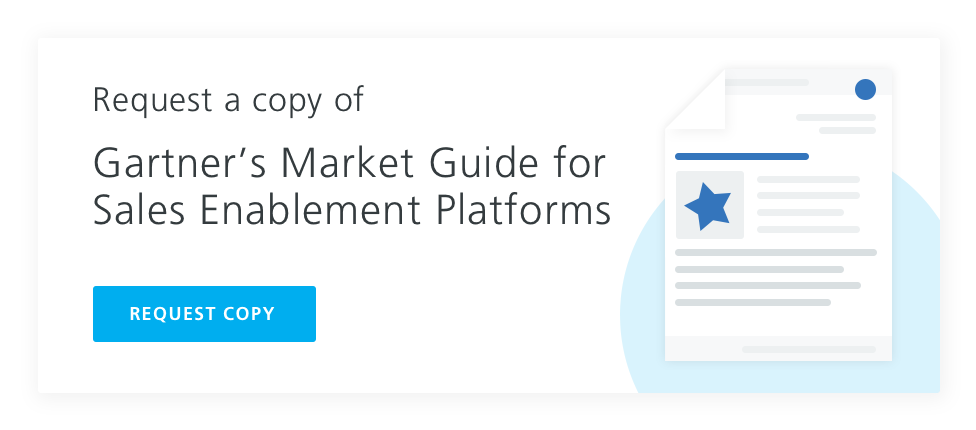uncategorized
Six Ways Sales Enablement Leaders Can Get the Most from Their Team
This guide outlines six important ways to optimize your sales enablement efforts and extract the best performance from your sales reps. Read on to learn:
- An understanding of holistic sales enablement
- Knowledge of how sales enablement impacts buyer engagements
- Best practices for successful onboarding and learning development programs
1. Cater Your Training Programs to Sales-Rep Learning Preferences
The guide’s first point covers the crucial topic of learning. Newly-hired sales reps, like employees in any other industry, are more effective when training aligns with their learning preferences. Lengthy eLearning programs and one-way conversations from subject matter experts aren’t always the best ways for new reps to learn.
Research shows that most knowledge is learned through “doing” rather than from “traditional” learning environments. They also point to some of their own research showing that the most effective learning methods are on-the-job learning, live classrooms, observation, and peer collaboration.
Sales-enablement leaders should take a second look at their learning and development programs. Organizations should employ training that supports visual, active and kinesthetic learning (where students carry out physical activities). Also, keep the delivery of information down to less than 15 minutes in length and using coaching technology that incorporates staged reinforcement questions.
2. Rethink When Onboarding Is “Done”
Many sales organizations aim to “decrease time to productivity” as they design their onboarding programs. However, the majority of high-performance sales organizations report that their onboarding continues for six months or more.
But we warn against these two extremes. One is to allow new salespeople to interact with buyers as early as day one. The other extreme is to shelter inexperienced salespeople from buyer interactions to the point where the new reps have difficulty grasping their organization’s best practices in the long term. Both extremes prevent the sales rep from becoming a high performer.
Rather than rushing hastily through the onboarding process or sheltering new reps to the point of ineffectiveness, organizations should focus on “rep readiness.” This means letting new reps gain real world, on-the-job experience in intervals.
And rather than waiting until the onboarding is “done,” reps should be allowed to apply knowledge as it’s acquired. This will mean dividing a training program’s content into smaller, more consumable segments and then weaving real-world practice into these learning segments.
3. Empower Sales Managers to Attract Top Talent
In every industry, the most-effective employees place high value on corporate culture and the people they work with. The vast majority of high-performance salespeople (87 percent according to industry analysts) report that their decision to join a new sales team is heavily influenced by who their new manager will be.
However, almost 60 percent of sales managers have stated that they’re not properly equipped to attract top talent at their organizations. But simply assuming that managers fully understand their role in the hiring process and can effectively execute networking for the right candidates and interviewing tactics is a giant leap of faith that often leads to open territories, bad hires and unnecessary legal risks.
Organizations should collaborate with HR and other leadership for creating effective ways to empower sales managers to commit to their role in talent acquisition. They should offer resources to enable managers to build the best teams, including role playing and certification.
4. Integrate Sales Asset Management with Learning and Coaching Platforms
Somewhat surprisingly, even with the availability of technology designed to manage content, over one third of all sales reps are still spending more than 20 hours per month creating or searching for buyer-facing content. According to the guide, almost half of low-performance reps have reported spending disproportionate time on content-related efforts, compared to fewer than 20 percent of high-performing reps.
Fortunately, fully-featured coaching and training platforms are now being incorporated into SAM (sales asset management) systems. SAM and coaching-platform integration is taking place through M&As and deep-integration partnerships.
To effectively take advantage of such integration, sales organizations should conduct audits of their content against how their reps will use the content in the sales process. With more than a third of all reps reporting that they spend more than 20 hours a month searching for and managing content, the productivity implications are significant.
5. Always Be Listening
The entire sales landscape – customers, markets and competitors – is changing at an increasing speed. Gathering real-time information about the changing environment, directly from the sales team, is now more crucial than ever. In other words, one-way communication to the sales team is no longer adequate. Organizations need to listen to reps on the front lines.
Proactive listening not only helps an organization gain relevant insight about the ever-changing sales landscape, but it also enables leadership to answer questions from the field. Every member of the sales team needs context around the changes and complexities of the environment in which they operate. The sales team therefore needs a centralized communications channel.
We advise that organizations practice field advocacy. Field advocacy is the listening side of sales communications. Field advocacy enables organizations to source useful information regarding products, buyers and competitors. It also allows organizations to collect feedback on programs and processes while enabling them to provide immediate answers to inquiries from reps.
With its overarching goal of maximizing rep/buyer interactions, the most logical place for sales advocacy programs to reside is the sales enablement function.
6. Create a Sales Enablement Charter
If you’re a sales enablement leader, you’re probably no stranger to the frustration of being asked to handle more initiatives than your resources can sustain. According to industry researchers, more than 80 percent of sales enablement leaders state they’re expected to take on more 10 “critical initiatives” over the next year.
We encourage sales organizations to create a sales enablement charter. To effectively create such a charter, an organization needs to evaluate why its sales enablement efforts exist and clearly identify the problems these efforts are meant to address. The charter should answer sales-enablement related questions such as “What do we do? Who do we do it for? Why do we do it?” Among other questions.
When scope creep is eliminated, sales enablement efforts flourish, leaders are less likely to burn out, and every rep on the sales team is better equipped.
The Bottom Line
Perhaps the biggest takeaway of this post is that the best way to get the most out of a sales team is to serve their needs first. When you focus on enriching your team and serving their needs, they’ll then be fully equipped serve your organization.
Cater to your team’s learning preferences, provide realistic onboarding programs and always be listening. The most important asset in any organization is its people, so make sure you’re fine-tuning that investment for the best possible performance.
Accent Technologies is the first and only SaaS company to bring together Sales AI and Content Management in a true Revenue Enablement Platform. We provide both sales and marketing with better visibility into the performance of their teams. This drives revenue through intelligent recommendations for complex sales scenarios and provides the data for rich analytics that power better coaching, forecasting, and long-term customer support. Learn more about our solutions or request a live demo to see it in action.












